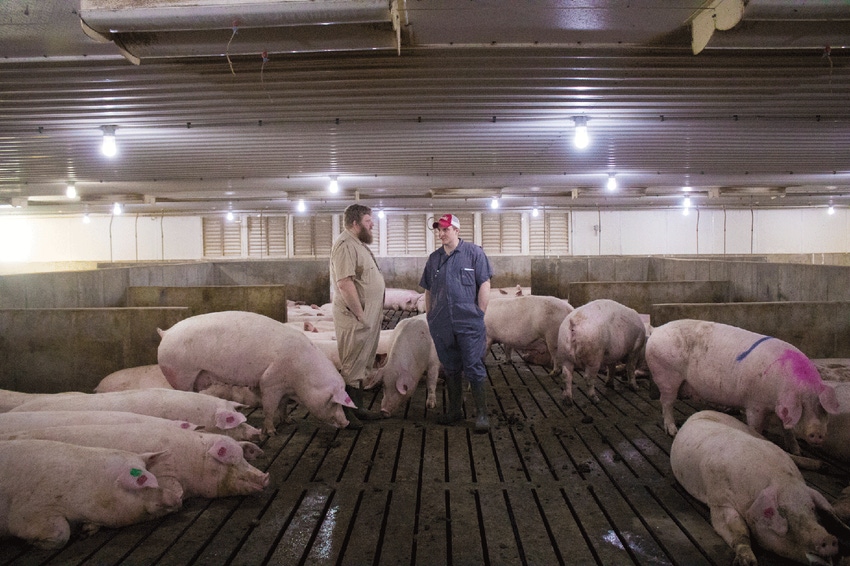Electronic sow feeding: Basic rules for success
Choosing the right ESF system is important, but issues can still arise, as with any feeding system.

Whether you’re running an electronic sow feeding system in a 4,000-head commercial sow farm or in a 150-sow intensive research complex, most herd managers would agree: Patience and positivity are key in training that sow or gilt.
Chet Mogler, who runs Pig Hill Farms with his father, two uncles and two first cousins in northwest Iowa, has found their ESF system vital to their 4,400-sow farm. In 2015, the fourth-generation family farm built a state-of-the-art facility and decided to change to large group pens.
“We didn’t want to have limited market access in the future if stalls were to become a big issue, so we wanted to find a group house system that worked well,” Mogler says. “The absolute biggest thing we did not want by going to group housing was to lose individual identity from a feeding capacity. We really liked the ESF station concept from the aspect that each sow is still an individual being fed to their exact diet.”
The Moglers quadrupled Pig Hill Farms’ production size. They looked at different systems and took several tours of sow group housing operations before settling on their system.
“With the ESF pens, sows do not have paper records following them around in the pen like you can in the stall barn, so very timely data we found was essential to making on-the-spot decisions,” Mogler says.
Mogler says another perk to their ESF system is all the other information they collect from the electronic tags. Having a single separation system with six stations lined up next to each other, the sows come out into one exit alley where a paint system can mark them for vaccinations and pregnancy checks, make sure they still have their ID tag, and perform a boar heat detection on them.
“We really feel there is more information available on the individual sows with ESF systems that can be captured to be used to improve their performance,” Mogler says.
Now instead of spending time in stalls, scraping manure with shovels, and sweeping and adjusting feed boxes, the Pig Hill Farms crew is checking no sow is off feed, and waterers and feed stations are working. They adjust their feed plan once at breeding, based on parity and body condition, and then set up feed plan curves to adjust as needed.
Mogler says by no means does ESF mean more labor; it may be even less.
Compare ESF systems
For producers considering converting to group housing and an ESF system, Mogler encourages them to inspect some for themselves. “Go talk to someone that has already done it. You don’t have to learn it all for yourself,” Mogler says. “You don’t have to be the pioneer anymore. There are enough people with group housing you can learn from their experiences.”
For Cameron Pewe, who grew up on a farrow-to-finish operation and had industry experience as a wean-to-finish supervisor, this is his first time managing gestation pens and an ESF system. He says the last two years at the South Dakota State University Swine Education and Research Facility has opened his eyes to how ESFs work. The SDSU gestation room is set up to demonstrate both pen gestation and the use of gestation stalls.
“It’s been a learning process for me, and once familiarizing myself with it, I would recommend both systems,” Pewe says. “I do not think there is enough scientific data to prove one is better than the other yet, but I am not against or for either system. They both work, and I think a combination of both is needed, so you can perform heat checks, breeding and pregnancy checks.”
The SDSU pen gestation system has three pens of 30 sows each. The feeders are activated by each sow’s ear tag, letting sows enter to eat an individually prescribed ration. Data is recorded during each feeding for sow eating habits. Two separate feed lines supply the ESF, which is equipped with blenders to individualize a diet for each of the 30 sows in a pen.
While Pewe says they have had minimal problems with the feeding system, a storm knocked out power one evening, and a power surge ruined a server. He recommends having the server on a surge protector and backing up data. The hardest part has been getting the gilts or stubborn sows trained on the station.
SDSU uses a training station, or a functional dummy, in its gilt development unit. Pewe says at times it helps to coax them into the station with feed on the ground, or to let them go hungry for a day.
“What we have had success with is getting them in there as gilts, before we are even thinking about giving them pre-breeding shots and synchronizing them,” he says. “It’s best to work with them then, so you are not stressing them out and you are not affecting how they are going to breed.”
“If she has a bad experience, she is less likely to go back to the feeder,” Pewe says. “If you are having problems getting one in there, it’s always best to take a break, walk away, let her have some time and always end on a good note.”
If a gilt or sow isn’t eating and does not respond to treatments in a day or two, she will bed moved to a stall and kept there. Pewe says they have found if she’s put back in the pen, other sows will follow her lead.
While several small producers have toured the SDSU gestation pens and ESF system to see if something similar would work for their barns, Pewe says it comes down to producer preference. “You need to see financially what you can afford and what’s going to fit best in your production system.”
Choosing the right ESF system is important, but issues can still arise, as with any feeding system.
Robert Drew, sow management specialist, Nedap Livestock Management, North America, says to look at management practices from your sows’ point of view. What makes them content, comfortable and productive?
“Since feed is a large percentage of input costs, it’s good to review your feed management practices often,” he says. “Evaluating data will show you ways to maximize your operation’s return on investment.”
Drew suggests these tips to fine-tune feed efficiency and utilization.
Reduce environmental stressors. Pigs respond quickly to environmental stress, and their responses can negatively impact performance. How is the building’s ventilation? Is the temperature optimal? Can your sows eat without interruption and without having to guard their feed from other sows? Forward exits in ESF systems can sometimes help minimize interaction between fed and unfed sows.
Adjust rations based on need. Not all sows have the same nutritional requirements. Precise, individual feeding based on parity, condition and stage of gestation or lactation ensures sows get the correct nutrition based on needs. An accurate way to meet each sow’s requirements is by collecting individual feed data and reviewing it with a nutritionist.
Measure individual sow feed intake. If a sow hasn’t eaten, chances are there’s a problem. Changes in individual feed consumption can help you recognize more widespread challenges, including pen or herd health problems, poor water quality or availability, ventilation challenges, and feed quality issues. Identifying the source of a problem quickly can help you adjust management protocols to get your sows’ productivity and health back on track.
Feed bin management. Look for leaks or excessive condensation inside, creating hang-up and compaction, as this leads to moldy feed. Routinely empty feed bins and, where possible, rotate bins to ensure feed delivery into the barn is fresh.
About the Author(s)
You May Also Like





